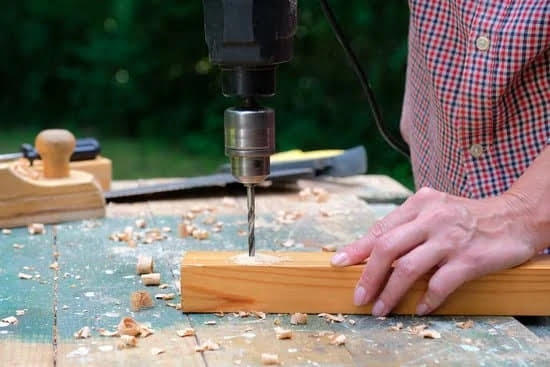Are you looking to take your woodworking tools to the next level? In this article, we will show you how to make a woodworking tool electronic control box, giving you the ability to customize and enhance the performance of your equipment. Electronic control boxes play a crucial role in the functionality of woodworking tools, and by creating your own, you can tailor it to fit your specific needs and preferences.
Whether you are a seasoned woodworker or just starting out, understanding the basics of electronic control boxes is essential. From selecting the right components to wiring and assembly, we will take you through each step of the process. Building your own control box not only gives you greater control over your woodworking tools but also allows for customization options that commercial products may not offer.
However, safety is paramount when working with electronic components. We will discuss important safety precautions that need to be taken when building and using an electronic control box for woodworking tools.
With careful attention to safety measures and detailed guidance on component selection and assembly, making your own electronic control box for woodworking tools can be a rewarding endeavor. Stay tuned as we delve into the essential components and functions, guiding you towards successfully creating an electronic control box that matches your unique woodworking needs.
Understanding the Basics
When it comes to woodworking tools, having an electronic control box is essential for ensuring precision and efficiency. An electronic control box is responsible for regulating the speed, power, and other functions of woodworking tools such as routers, lathes, and saws. In this section, we will delve into the basics of electronic control boxes and the crucial components that make them work.
Components of an Electronic Control Box
The main components of an electronic control box for woodworking tools include a microcontroller, power supply unit, display interface, input devices (such as buttons or knobs), and output devices (such as relays or motor drivers). The microcontroller acts as the brain of the control box, receiving input from the user and controlling the output to the woodworking tool.
Functions of an Electronic Control Box
The primary function of an electronic control box in woodworking tools is to regulate speed and power. Depending on the type of woodworking tool, the control box may also have additional functions such as reversing the motor direction or activating safety features. By understanding these basic functions and components, woodworkers can gain a deeper insight into how electronic control boxes operate and customize them to suit their specific needs.
Importance of Understanding the Basics
Understanding the basics of electronic control boxes is crucial for woodworkers who are looking to build their own. By gaining knowledge about the components and functions, individuals can ensure that their electronic control box meets their requirements and operates safely. In the next section, we will explore safety precautions that need to be taken when working with electronic components in woodworking tools.
Safety Precautions
Building your own electronic control box for woodworking tools can be a fulfilling and rewarding experience. However, it’s essential to prioritize safety when working with electronic components. Whether you are an experienced woodworker or new to DIY electronics, taking the necessary precautions can prevent accidents and ensure the success of your project. In this section, we will discuss the safety measures and precautions that need to be taken when working with electronic components.
First and foremost, always work in a well-ventilated area to avoid inhaling any fumes from soldering or other electronic processes. Additionally, wearing protective gear such as gloves and safety glasses is crucial to protect yourself from any potential hazards. When handling electrical components, make sure to switch off the power source and discharge any capacitors to avoid electric shock.
It’s also important to inspect all wires, connectors, and components for any signs of damage before use. Using damaged or faulty parts can lead to malfunctioning of the control box or pose safety risks. Moreover, following the manufacturer’s guidelines for each component is highly recommended to ensure that you are using them properly and safely.
| Safety Measure | Precaution |
|---|---|
| Work in a well-ventilated area | Avoid inhaling fumes from soldering or other electronic processes |
| Wear protective gear | Gloves and safety glasses should be worn at all times |
| Inspect components for damage | Avoid using damaged or faulty parts |
Selecting the Right Components
Building an electronic control box for woodworking tools requires selecting the right components to ensure that it functions efficiently and safely. There are several key components that you will need to consider when building your electronic control box, including the power supply, control board, interface components, and safety features.
When choosing a power supply for your electronic control box, it is essential to select one that can provide the necessary voltage and current for your woodworking tools. You will also need to consider factors such as input voltage range, efficiency, and safety features. Additionally, it is crucial to select a power supply that meets industry standards and certifications to ensure safe operation.
The control board is another critical component of the electronic control box. This board will be responsible for controlling the various functions of your woodworking tools, so it is essential to choose a high-quality board with the appropriate number of inputs and outputs. You may also want to consider additional features such as USB connectivity or wireless capabilities for remote monitoring and control.
In addition to the power supply and control board, you will also need to select interface components such as switches, knobs, and indicator lights. These components are essential for user interaction with the electronic control box and should be chosen based on their durability, ease of use, and compatibility with the overall design of the control box. Safety features such as emergency stop buttons and overload protection should also be included in your component selection to ensure safe operation.
By carefully considering each of these components and selecting high-quality, compatible parts, you can ensure that your electronic control box functions effectively and safely within your woodworking tools setup. Conducting thorough research on each component’s specifications and capabilities will help you make informed decisions when building your electronic control box.
| Component | Considerations |
|---|---|
| Power Supply | Voltage/current requirements; input voltage range; efficiency; safety features |
| Control Board | Number of inputs/outputs; additional features (USB connectivity/wireless); quality |
| Interface Components | Durability; ease of use; compatibility with design; safety features |
Wiring and Assembly
Now that you have selected the right components for your woodworking tool electronic control box, it’s time to move on to the wiring and assembly process. This step is crucial in ensuring that your control box functions properly and safely. Below are detailed step-by-step instructions on how to wire and assemble the electronic control box, including a detailed wiring diagram.
Gather Your Tools and Components
Before you begin the wiring and assembly process, make sure you have all the necessary tools and components ready. This includes a soldering iron, solder, wire cutters/strippers, electrical tape, a screwdriver, and of course, all the electronic components that you selected in the previous step.
Wiring Process
Start by carefully following the wiring diagram that you have created for your electronic control box. Begin by connecting the power source to the appropriate terminals on your control box. Then, proceed with connecting each component according to the diagram. Make sure to double-check each connection as you go to avoid any mistakes.
Assembly Process
Once all the components are correctly wired together, it’s time to assemble them into a proper enclosure or housing for your electronic control box. This may involve mounting circuit boards or panels inside a suitable casing and securing them in place using screws or other fastening methods. Ensure that all wires are neatly organized within the enclosure to prevent any potential hazards.
By following these step-by-step instructions, along with your detailed wiring diagram, you can successfully wire and assemble your own electronic control box for woodworking tools. Remember to take your time throughout this process and double-check each step to ensure everything is connected correctly. Once assembled, your control box will be ready for testing before being integrated into your woodworking tools.
Testing and Troubleshooting
When it comes to building an electronic control box for woodworking tools, testing and troubleshooting are crucial steps to ensure that the box functions properly and safely. Here are some tips on how to test the electronic control box and troubleshoot any issues that may arise during the assembly process:
Testing:
- Use a multimeter to check for continuity in the wiring connections. This will help ensure that there are no loose or faulty connections.
- Test each component individually to make sure they are functioning as intended. This includes testing the power supply, relays, and any other electronic components used in the control box.
- Verify that the control box is receiving the correct input voltage and that all connections are secure.
Troubleshooting:
- If there is a problem with the electronic control box, start by checking for any loose or disconnected wires. Reconnect any wires that may have come loose during assembly.
- If the control box is not working as expected, double-check the wiring diagram to ensure that all components are connected correctly according to their specifications.
- If certain functions of the woodworking tool are not working after installing the electronic control box, troubleshoot each component individually to identify any faulty parts or connections.
By following these testing and troubleshooting tips, woodworkers can ensure that their electronic control box is functioning properly and safely, allowing them to make efficient use of their woodworking tools.
Remember to always follow safety precautions when testing or troubleshooting an electronic control box for woodworking tools. It’s important to work methodically and carefully when dealing with electrical components to avoid any accidents. With these tips in mind, woodworkers can confidently build and test their own electronic control boxes for their woodworking tools.
Customization Options
When it comes to building your own electronic control box for woodworking tools, there are several customization options available that can enhance the functionality and design of your control box. These customization options allow you to tailor the electronic control box to suit your specific needs and preferences.
Here are some customization options to consider when building your electronic control box:
- Adding variable speed control: By incorporating a variable speed control feature into your electronic control box, you can have greater flexibility and precision in adjusting the speed of your woodworking tools. This feature is especially useful for tasks that require different levels of speed and power.
- Integrating safety features: You can enhance the safety of your woodworking tools by adding safety features such as emergency shut-off switches or overload protection mechanisms to your electronic control box. These features can provide added peace of mind and protection while using your woodworking tools.
- Modifying the design: Customizing the design of your electronic control box allows you to create a unique and personalized look that reflects your individual style. Whether it’s choosing a specific color scheme or adding embellishments, modifying the design of your control box can make it stand out in your workshop.
By considering these customization options, you can take your DIY electronic control box to the next level, providing not only improved functionality but also a personalized touch that reflects your woodworking preferences. The key is to carefully plan and research each customization option before integrating it into your electronic control box project. With careful consideration and attention to detail, you can create a customized electronic control box that meets all of your woodworking tool needs.
Conclusion
In conclusion, creating your own electronic control box for woodworking tools can be a rewarding and beneficial project. Not only does it allow for customization and personalization, but it also gives woodworkers a better understanding of the inner workings of their tools. By following the outlined steps and safety precautions, anyone with a basic understanding of electronics can successfully build an electronic control box for their woodworking tools.
Understanding the basics and selecting the right components are crucial steps in ensuring the functionality and efficiency of the electronic control box. Additionally, taking proper safety precautions when working with electronic components is essential to prevent any accidents or mishaps. Once these steps are complete, wiring and assembly become easier to navigate, especially with the detailed instructions provided.
Testing and troubleshooting any issues that may arise during the assembly process is also a crucial step that should not be overlooked. By thoroughly checking each component and conducting tests before use, woodworkers can ensure that their homemade electronic control box operates correctly.
Finally, with various customization options available, woodworkers have the freedom to modify their electronic control box according to their specific needs and preferences. So if you’re up for an exciting DIY project, consider building your own electronic control box for your woodworking tools today.
Frequently Asked Questions
How Do You Make a Tool Board?
Making a tool board involves selecting the appropriate board for your space, marking and measuring where you want to place your tools, and installing hooks or pegs to hang the tools. The key is to keep everything organized and easily accessible.
How Do You Store Tools on the Wall?
Storing tools on the wall can be done by using different types of storage solutions such as pegboards, shelves, or magnetic strips. It’s important to consider the weight of the tools and how often they are used when deciding on the best storage method.
What Is an Alternative to Peg Board for Tools?
An alternative to pegboard for storing tools could be a slatwall system. Slatwalls offer more flexibility in terms of arranging and rearranging hooks and accessories compared to pegboards. They also provide a sleeker look for those who prefer a modern aesthetic in their workspace.

Hi everyone! I’m a woodworker and blogger, and this is my woodworking blog. In my blog, I share tips and tricks for woodworkers of all skill levels, as well as project ideas that you can try yourself.





